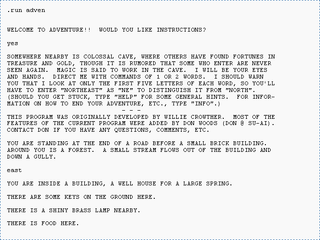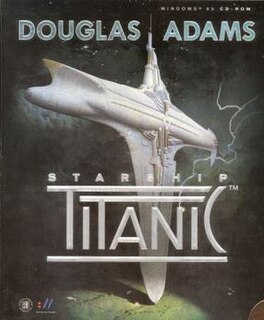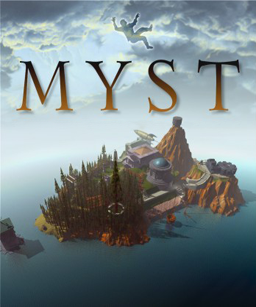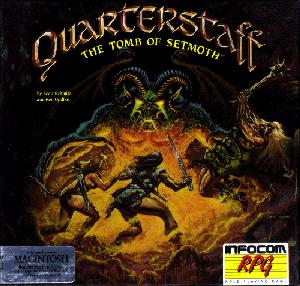
Interactive fiction, often abbreviated IF, is software simulating environments in which players use text commands to control characters and influence the environment. Works in this form can be understood as literary narratives, either in the form of interactive narratives or interactive narrations. These works can also be understood as a form of video game, either in the form of an adventure game or role-playing game. In common usage, the term refers to text adventures, a type of adventure game where the entire interface can be "text-only", however, graphical text adventures still fall under the text adventure category if the main way to interact with the game is by typing text. Some users of the term distinguish between interactive fiction, known as "Puzzle-free", that focuses on narrative, and "text adventures" that focus on puzzles.

Indiana Jones and the Last Crusade: The Graphic Adventure is a graphic adventure game, released in 1989, published by Lucasfilm Games. It was the third game to use the SCUMM engine.

The Dig is a point-and-click adventure game developed by LucasArts and released in 1995 as a CD-ROM for PC and Macintosh computers. Like other LucasArts adventure games, it uses the SCUMM video game engine. It features a full voice-acting cast, including voice actors Robert Patrick and Steve Blum, and a digital orchestral score. The game uses a combination of drawn two-dimensional artwork and limited, pre-rendered three-dimensional clips, with the latter created by Industrial Light & Magic.

Starship Titanic is an adventure game developed by The Digital Village and published by Simon & Schuster Interactive. It was released in April 1998 for Microsoft Windows and in March 1999 for Apple Macintosh. The game takes place on the eponymous starship, which the player is tasked with repairing by locating the missing parts of its control system. The gameplay involves solving puzzles and speaking with the bots inside the ship. The game features a text parser similar to those of text adventure games with which the player can talk with characters.

Myst is a graphic adventure/puzzle video game designed by the Miller brothers, Robyn and Rand. It was developed by Cyan, Inc., published by Broderbund, and initially released for the Macintosh in 1993. In the game, the player's character travels via a special book to the island of Myst. From there, solving puzzles allows the player to travel to four other worlds which reveal the backstory of the game's characters, one of which the player must eventually choose to aid.

Riven is a puzzle adventure video game. It is the sequel to Myst and second in the Myst series of games. Developed by Cyan Worlds, it was initially published by Red Orb Entertainment, a division of Broderbund. Riven was distributed on five compact discs and released on October 31, 1997, in North America; it was later released on a single DVD-ROM on August 17, 1998, with improved audio and a fourteen-minute "making-of" video. In addition to the PC versions, Riven has been ported to several other platforms.

Pathways into Darkness is a first-person shooter adventure video game developed and published by Bungie in 1993, for Apple Macintosh personal computers. Players assume the role of a Special Forces soldier who must stop a powerful, godlike being from awakening and destroying the world. Players solve puzzles and defeat enemies to unlock parts of a pyramid where the god sleeps; the game's ending changes depending on player actions.

Uru: Ages Beyond Myst is an adventure video game developed by Cyan Worlds and published by Ubisoft. Released in 2003, the title is the fourth game in the Myst canon. Departing from previous games of the franchise, Uru takes place in the modern era and allows players to customize their onscreen avatars. Players use their avatars to explore the abandoned city of an ancient race known as the D'ni, uncover story clues and solve puzzles.

The 7th Guest is an interactive movie puzzle adventure game, produced by Trilobyte and originally released by Virgin Interactive Entertainment in April 1993. It is one of the first computer video games to be released only on CD-ROM. The 7th Guest is a horror story told from the unfolding perspective of the player, as an amnesiac. The game received a great amount of press attention for making live action video clips a core part of its gameplay, for its unprecedented amount of pre-rendered 3D graphics, and for its adult content. In addition, the game was very successful, with over two million copies sold. It, alongside Myst, is widely regarded as a killer app that accelerated the sales of CD-ROM drives. The 7th Guest has subsequently been re-released on Apple's app store for various systems such as the Mac. Bill Gates called The 7th Guest "the new standard in interactive entertainment".

The action-adventure genre is a video game genre that combines core elements from both the action game and adventure game genres.

The Fool's Errand is a 1987 computer game by Cliff Johnson. It is a meta-puzzle game with storytelling, visual puzzles, and a cryptic treasure map. It is the tale of a wandering Fool who seeks his fortune in the Land of Tarot and braves the enchantments of the High Priestess. A sequel titled The Fool and His Money was released October 25, 2012.

Titanic: Adventure Out of Time is a 1996 point-and-click adventure game developed by CyberFlix and published in the United States and United Kingdom by GTE Entertainment and Europress respectively, for Microsoft Windows and Macintosh. It takes place in a virtual representation of the RMS Titanic. The player assumes the role of a former British spy who, during the London Blitz, is sent back in time to the Titanic and must complete a previously failed mission to prevent World War I, the Russian Revolution, and World War II. The gameplay involves exploring the ship and solving puzzles. There are multiple outcomes and endings to the game depending on the player's interactions with characters and use of items.

Bad Mojo is an adventure video game by Pulse Entertainment, released in 1996. The player is cast as Roger Samms, an entomologist planning to embezzle money from a research grant to escape his sordid life above an abandoned bar. An accident with his mother's enchanted locket unleashes the bad mojo, turning him into a cockroach. The storyline in Bad Mojo is loosely based on Franz Kafka's 1915 novella The Metamorphosis. In the game, the cat's name is Franz and the main character Roger Samms is an imperfect anagram of the lead character in Metamorphosis. The gameplay consists of guiding the cockroach through a series of puzzles.

Myst V: End of Ages is a 2005 adventure video game, the fifth installment in the Myst series. The game was developed by Cyan Worlds, published by Ubisoft, and released for Macintosh and Windows PC platforms in September 2005. As in previous games in the series, End of Ages's gameplay consists of navigating worlds known as "Ages" via the use of special books and items which act as portals.

3 in Three is a 1989 metapuzzle computer game designed by Cliff Johnson and published by Cinemaware and Inline Design.

Curse of Blackmoor Manor is the 11th game in the Nancy Drew point-and-click adventure game series by Her Interactive. The game is available for play on Microsoft Windows platforms as well as on DVD, Steam, and GOG.com released a digital version on their site. It has an ESRB rating of E for moments of mild violence and peril. Players take on the first-person view of fictional amateur sleuth Nancy Drew and must solve the mystery through interrogation of suspects, solving puzzles, and discovering clues. There are two levels of gameplay, Junior and Senior detective modes, each offering a different difficulty level of puzzles and hints; however neither of these changes affect the actual plot of the game. The game is loosely based on a book entitled The Bluebeard Room (1985).

Quarterstaff: The Tomb of Setmoth is an interactive fiction role-playing video game developed by Scott Schmitz and Ken Updike and released by Infocom for Macintosh in 1988. The game features a text parser, graphics, a dynamically updated map, and a graphical interface that incorporates Mac OS hierarchical menus.
An adventure game is a video game in which the player assumes the role of a protagonist in an interactive story driven by exploration and/or puzzle-solving. The genre's focus on story allows it to draw heavily from other narrative-based media, literature and film, encompassing a wide variety of literary genres. Many adventure games are designed for a single player, since this emphasis on story and character makes multiplayer design difficult. Colossal Cave Adventure is identified as the first such adventure game, first released in 1976, while other notable adventure game series include Zork, King's Quest, The Secret of Monkey Island, and Myst.

Anastasia: Adventures with Pooka and Bartok is a Fox Interactive puzzle video game based on the 1997 animated film Anastasia. Released on November 25, 1997, it was produced by David Wisehart. Wisehart also served as voiceover director. The game had an estimated budget of US$800,000.

Jewels of the Oracle is a 1995 adventure game developed by ELOI Productions and published by Discis Knowledge Research Inc. It was released on Macintosh, PlayStation, Sega Saturn, and Windows. A sequel developed by Bardworks and published by Hoffman and Associates was released in 1998 entitled Jewels II: The Ultimate Challenge.


















